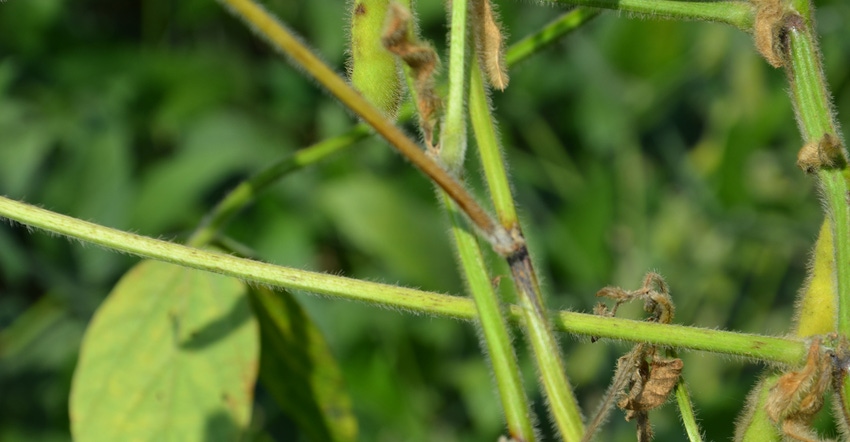
Add another name to your list of soybean diseases to scout for in the latter part of the season. Stem canker isn’t new, but it needs the right weather conditions to flourish. It made an appearance in some fields in 2019.
It’s not a disease that gets a lot of attention compared to diseases such as sudden death syndrome or brown stem rot, because it usually affects isolated plants and doesn’t cause big yield losses. However, under the right conditions, it can be a problem worth noting and watching.
Steve Gauck, a Beck’s sales agronomist based near Greensburg, Ind., found stem canker this year. Beck’s sponsors Soybean Watch ’19. He actually found the disease in a different field than the Soybean Watch ’19 field. He was scouting an additional field on his way to inspect the Soybean Watch ’19 field.
“It’s easy to spot because in the early stages, brownish lesions appear at nodes, usually on the lower stem first,” Gauck says. “They’re easy to see because they give the plant an ugly appearance.”
What you should know
The Purdue University Corn and Soybean Field Guide says reddish-brown lesions can form at lower nodes after the R3 stage if a plant is infected by stem canker. Pods are forming during the R3 stage. The guide notes that in advanced stages, the cankers can enlarge and girdle the plant, killing it.
Once leaves die, they typically remain attached, according to the guide. Infections that start early in the season are typically more troublesome. Gauck discovered stem canker in the field he visited in mid-September.
The disease is caused by a fungus that survives in surface soybean residue. Spores infect new plants. Infections tend to become worse when warm, wet conditions develop during the vegetative growth stage. In this case, “warm” means 82 to 93 degrees F. The field where stem canker was detected was exposed to wet conditions and high temperatures in late June and early July.
The Purdue guide notes that you’re more likely to see symptoms in fields with high soil fertility at high plant populations. Ironically, this field doesn’t meet either of those criteria.
“The reason we visited was because the stand was poor in a good part of the field,” Gauck explains. The population ranged from 20,000 to 50,000 plants per acre. Replanting wasn’t an option because it was so late in the season by the time the field dried up and the operator had time to replant.
“We wanted to see how individual plants could compensate at such low populations,” Gauck says. “They certainly did, putting on multiple branches and lots of nodes. However, in some cases, the stand was so thin that plants still couldn’t make up for all the plants which were missing.”
Some varieties have more resistance to stem canker than others. If you notice a problem with the disease, Gauck suggests paying attention to resistance ratings when selecting varieties.
About the Author(s)
You May Also Like




